what is plastic mold?
What Is Plastic Mold?
What is plastic mold?
The tooling used for plastic injection molding is called a plastic mold or plastic injection mold. The plastic mold is made from a combination of steel plates and other mold components, coupled to form an overall mold, which is then reliably assembled and installed in an injection molding machine, then applies a thermoplastic resin to the desired shape to fulfill the intended purpose.
Most plastic products are molded by plastic molds.
According to the molding plastic characteristics, plastic molds are divided into thermosetting and thermoplastic mold.
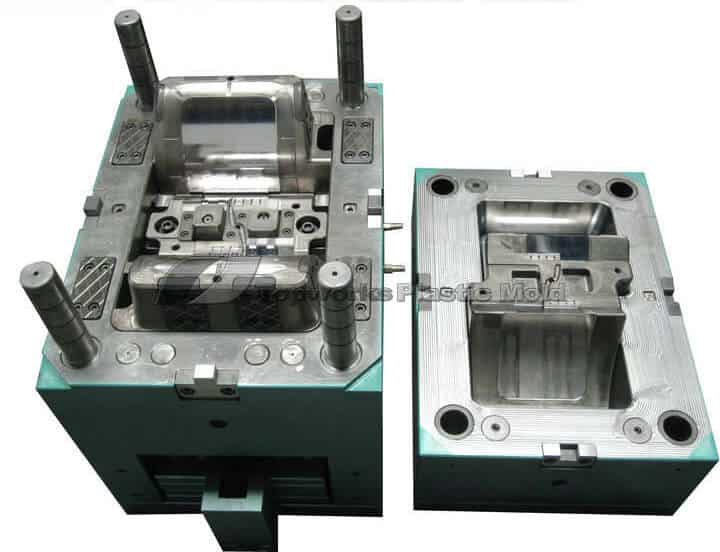
Based on the molding process, the plastic mold is divided into
- injection mold,
- blow mold,
- casting mold,
- pressing mold, and so on.
The injection mold comprises two main sections: the moving half and the fixed half.
The moving half is mounted on the moving platen of the injection molding equipment, and the stationary half is mounted on the stationary platen.
Over the injection molding, the moving and the stationary half are shut to develop an injection structure and a cavity structure.
Once the mold is open, the moving half and the stationary half are split up to clear away the plastic item from the plastic mold.
To decrease the mold design and developing period, the majority of the plastic molds work with standard mold bases.
https://res.cloudinary.com/dl8a9jvpa/video/upload/v1572574321/plastic%20mold.mp4
The plastic mold is mainly composed of
- Injection system,
- The temperature control system,
- Part forming system
- Ejection system.
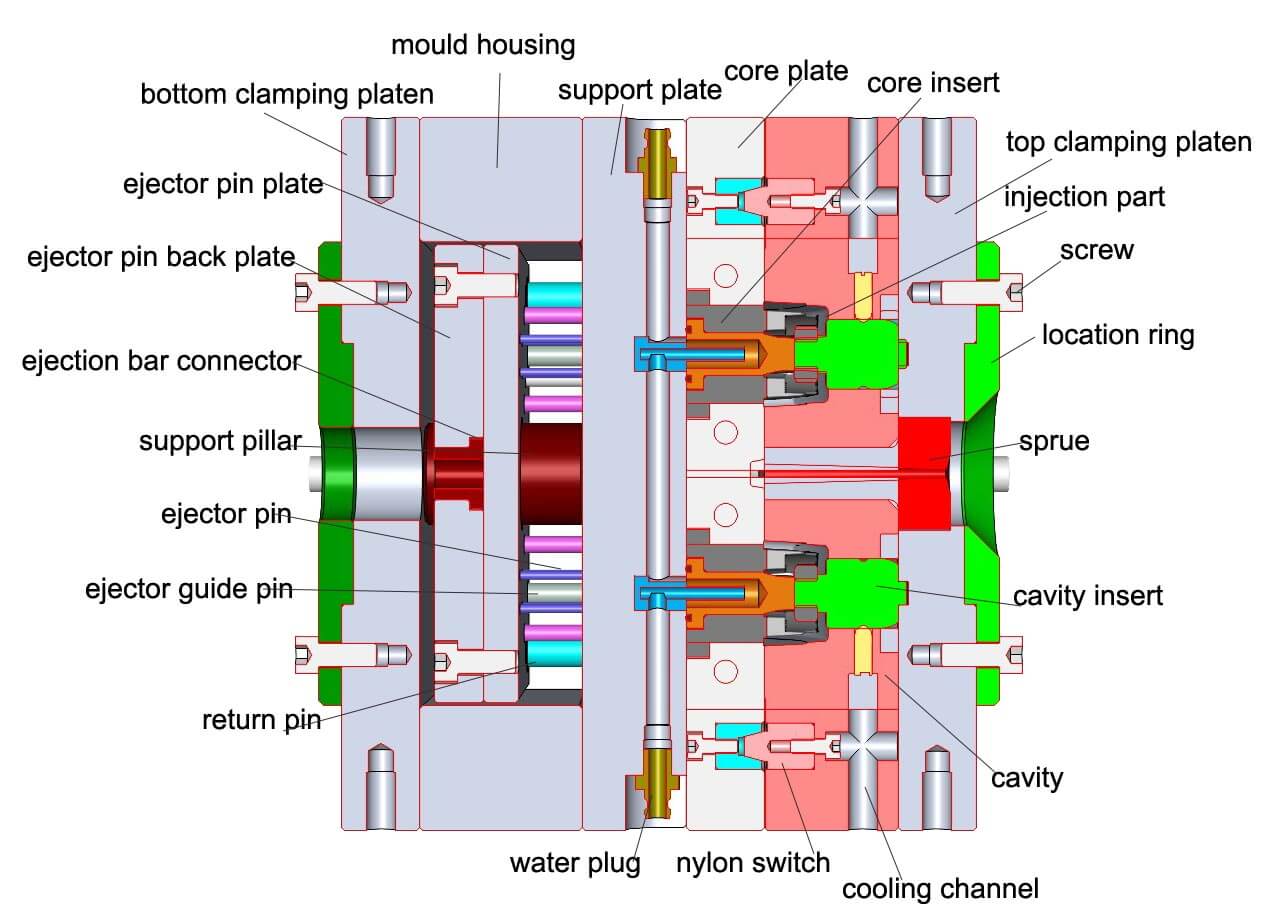
The injection system and the part forming system are in direct contact with the plastic, and they change with the different plastics and products.
Those 2 systems are the most complex and most varied parts in the mold and require the highest finish and accuracy.
The part-forming process refers to the melted plastic heated by an injection molding machine is injected into the mold cavity.
After cooling and solidification, it gets the molded products. Which simplifies as mold close - injection - pressure - cooling - mold open - ejection.
What is plastic mold?
The plastic injection mold is generally composed of the following parts:
- mold base: generally choose standard mold base from standard mold base manufacturing factories, such as LKM, DME, HUSCO...
- the mold insert: it is used to form plastic products; a plastic mold factory normally makes it by itself; most of the processing time is spent on producing mold inserts.
- Mold auxiliary parts: they include location ring, nozzle bushing, support pillar, ejector plate, guide bushing, guide pin, lifting ring, and so on.
- The four major systems:
- Injection system(runner): Injection system refers to the flow path part before the melted plastic enters the cavity from the nozzle, including the main runner, the cold slug, the sub-runner, and the gate. It is directly related to the molding part quality and production efficiency.
- ejection system: ejector pins, blade pins, and sleeves.
- heating and cooling system: hot runner, preheating device, cooling water;
- venting system: venting slot, parting surface venting, ejector pin venting, and insert venting;
- special mechanism: if the product has the undercut or sidewall hole, the plastic mold needs to design the side core pulling mechanism (also called the slide), the inclined core pulling mechanism (also called the lifters), the oil cylinder (when the side core pulling distance is long).
Classification of injection mold:
- 2 plates mold: another name of the sprue gate mold, also known as the single parting line type plastic injection mold, its characteristic is the simple mold structure, but the sprue is a part of the injection molded part, and it needs to be manually removed later, and plates mold structure is widely used for various kinds of mold.
- 3 plates mold: the pinpoint gate mold and the double parting line type injection mold. Its gate characteristic is pinpoint, and the gate cross-section is small. The injection molded part appearance is good, and because it does not need the manual removal of the gate later, it is advantageous for the automation production. But three plates mold structure is more complex, and the cost is higher. It is generally applicable to small and medium plastic parts. And plastic molding material is with good fluidity.
Difference:
The most significant difference between the three plate mold and the two plate mold is that the three plate die has an extra runner plate (automatic remove runner).
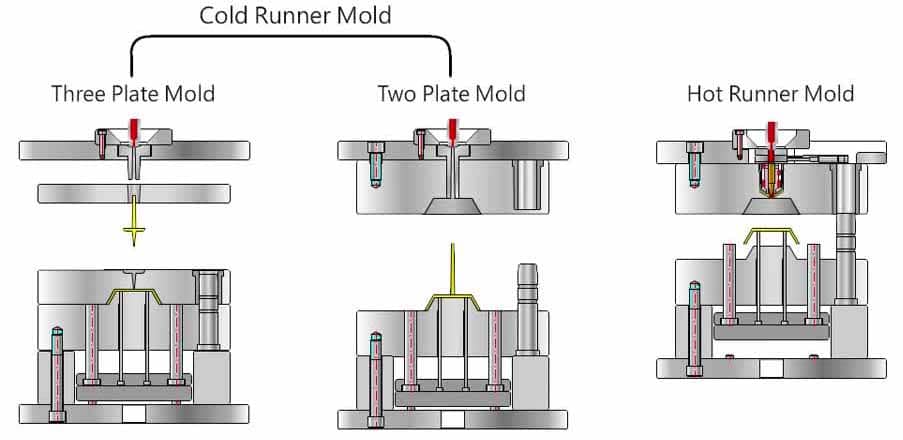
The main plastic mold system
There are four key concepts to consider when designing a mold, and the next few lines provide information on how to design a mold.
1.Runner
To design a good runner, its geometry, size, and layout also should be correct, in addition to its cooling ability, ejectability, and minimization of regrinds. It is best to fill all cavities at once using a balanced runner system to minimize cycle time and ensure the greatest possible dimensional integrity of the molded product.
The long and thin runners or any runner shaped like a half-moon or a half-circle need to be filled at higher pressures to prevent the mold from cooling down prematurely and causing incomplete parts. The length of a long and thick runner leads to an increase in regrinding, which, in turn, reduces the efficiency of the molding process.
In cases where the runners' intersections should have ejector pins positioned to eject with sufficient force, ejecting the runner should still be possible. On the ejector portion of the mold, it is preferable to have runners installed to be forced out with the ejector.
-
Main Runner
This is a portion of the mold that attaches the nozzle of the injection molding press to the sprue. The top of the sprue is concave for touching with the nozzle.
The one end diameter of the sprue needs to be a little bigger than the nozzle size (0.8 mm) to prevent excessive streaming and avoid the two from being clogged due to wrong positioning.
The size of the one end is determined by the item's dimensions, generally 4-8 millimeters. The size of the runner ought to be increased inwards at an angle of 3° to 5° to aid the ejection of runners.
In addition to the correct runner geometry, size, and layout, good runners must also be cool quickly, ejectable, and have very little regrind. For filling all cavities simultaneously, a balanced runner system is necessary, which minimizes cycle time and allows the molded product to remain dimensionally intact.
Long and thin runners or half-moon runners require higher injection pressures to ensure that parts aren't rendered incomplete if the mold cools too quickly. Long and thick runners result in more regrind, which decreases the effectiveness of the operation. Ejector pins should be in place to expel the runners at the convergence of the cold runners.
Runners should be installed at the core half of the mold so that the ejector should be able to push these out of the mold.
-
Sub-runner
This is basically a small channel joining the primary runner and each cavity for the multi-cavity plastic mold building. As a way to come up with the melted resin occupies the cavity in equivalent velocity, the layout of the runners for the mold needs to be symmetrical and equidistantly spread.
The form and dimension of the runner impact the stream of the plastic melt, the discharge of the item, and the mold building. In many cases, the trapezoidal or semi-circular cross-sections are employed for runner design, and they are machined on ejection half of the mold for the ejector pin to push out.
The exterior of the runner has to be finished to minimize the stream resistance to produce a quicker filling speed. The dimensions of the runner vary according to the sort of plastic material, the dimensions, and the thickness of the item.
For most thermoplastics, the runner's cross-sectional circumference is not over 8 millimeters, Maximum 10-12 millimeters, Minimum 2-3 millimeters. The cross-sectional region needs to be created as small as possible to decrease the resin misuse and shorten the cooling period.
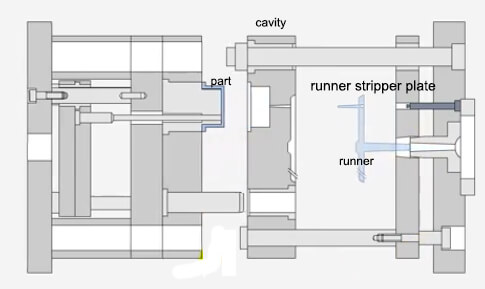
3 plates mould
-
Cold Slug
It is deemed a prolonged runner situated at the far tip of the main runner to capture the cold resin among the 2 cycles, therefore avoiding the possible blocking of the main runner or the gate.
Should the cold resin blend directly into the cavity, the interior stress will probably stem from the injection-molded item.
The Cold slug features a diameter around 8.5-10.5 mm and 6.5 mm deep. To be able to help ejection, the base is usually grabbed by a puller. The tip of the puller needs to be created to be a zig-zag catch or a depressed slot to ensure that the cold slug might be easily removed in the course of ejection.

2.Temperature Control
To meet up the mold temperature demands of the injection molding procedure, a temperature control technology is necessary to regulate the heat level of the mold.
For injection molds to inject thermoplastics, the cooling system is usually built to cool the mold. The most popular way of mold cooling would be to drill cooling water lines inside the mold and work with moving cool liquid to take out the mold's heat.
Along with heating the mold, hot liquid or vapor should be considered within the water lines, and a heating bar might be mounted within and around the mold.
Mold cooling is an essential metric for determining the quality of the product given to the customer in terms of dimensional integrity, physical properties, surface finish, shrinkage, and the strength of weld lines.
Irregular cooling inside a long cavity will result in poor warpage control. Cooling all core pins is imperative, especially if the ratio of length to the diameter of the core exceeds four. Hot core pins result in surface imperfections and prolong the molding process.
The heat transfer efficiency of a water layer on the pins is much higher than that of the air layer. Ejector pins for flexible resins need cooling before ejection.
The ability to control the temperature of the sprue puller pin area reduces the time it takes to cycle the mold and the number of interruptions it causes during the ejection process.
For effective temperature control, the fluid flow must be high-volume and turbulent.
Prohibiting corrosion within the water lines is achieved by using stainless steel mold plates; other ways to prevent corrosion include plating the cooling channel or adding rust inhibitors into the water. The mold plates must be thick enough to accommodate the cooling channels of proper size.
3.Venting
This is a not deep groove cut in the mold to release the air within the cavity or the soft plastic material introduced.
Should the melted resin is shot into the cavity, this kind of trapped air in the cavity needs to be released out of the mold via the grooves at the end of the streaming front in time.
Or else, the item will likely have voids inside(especially for transparent resin injection molding), vulnerable weld lines, um-completed shot -. Perhaps the build-up of air would produce excessive-high temperatures because of the high pressure to make the item charred.
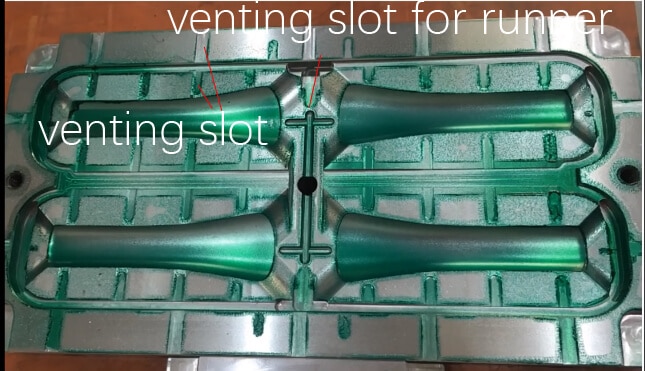
The venting grooves might be situated both at the end of the melt stream and on the P/L of the mold. The last-mentioned place is a shallow slot that is a depth of 0.03-0.2mm and a width of 2-6.5mm cut on the cavity side of the plastic mold.
The vent grooves won't escape much-smelted resin throughout the shot since the melted resin will cool down around this location and congeal the grooves. The placement of the vent grooves ought not to be confronting the operator to avoid an unexpected splash shot of melted resin. The gap between the ejector pins and the ejector hole, between the ejector bar stripper plate and the core insert, may be a method to release the air.
plastic mold venting slots size:
4.Ejection
Ejector pins, sleeves, stripper rings, or stripper plates should work without obstruction to realize consistent ejection.
A guided ejector system allows for precision alignment of the core and pins and will also bear the loads so that the pins do not wear out and go out of alignment. An early return system is another safety feature that should be included.
The early Return system drives all ejector pins into seated positions before the mold closes, ensuring no accidental contact with the ejector that has not fully retracted. Every mold incorporating ejector pins or sleeves under any slides should have a protector pin.
To prevent the ejection pins from colliding with the slides, this lock secures it in the retracted position. Plastic mold should use special ejection systems for parts that consist of flexible, thin-walled, deep sections that are difficult to eject.
Elements of a Plastic Mold
Designers and people interested in creating a mold should realize that molds are basically made up of a number of different elements from which to choose a design that is appropriate for use.
The following elements are essential to every injection mold:
1. Determination of the cavity space(s) with corresponding cores ( molds can have up to 144 cavities for preform mold).
2. A conduit for conveying (hot) plastics from the machine nozzle to the mold cavity.
You can choose from
- Cold runners (two or three plate)
- Hot runners (of various types)
3. Ventilation:
Natural venting or vacuum venting are both options.
4 A cooling system designed to allow the molded product to be ejected from the cavity
5. Various options are provided for ejecting the molded article:
These include
- Hand removal
- Sleeves and pins for ejectors
- Stripper
- Ejection by air
- Force ejection
- Various methods of in-mold product removal methods
- Automated removal methods
6. Attaching the mold to the machine:
Several methods are available
- Molds are limited to one machine
-
Mold can be used on more than one machine
-
Easy mold change options
7. Aligning the cavities and cores:
The following methods may be used:
- No alignment feature
- Brass bushings and pins (2, 3, or 4)
- Leader pins and bushings between ejector pin plates
- Taper locker between individual cavities and cores
8. A number of (mold) plates would be required here to support and back the above elements.
Although each of these features can increase the cost of a mold (often quite significantly), they can also improve the productivity of a mold and lower the cost of a product. If you are looking to choose the most suitable (and most economical) mold for a particular application, these factors may not all be necessary.
Plastic Mold Gates:
The gate of plastic mold refers to a short flow path between the runner and the cavity, which is the entrance of the resin into the cavity.
It is a channel connecting the runner and the cavity.
- The cross-sectional area of the gate can be equal to the runner, but it is usually reduced. So it is the smallest part of the entire runner system.
- The design of the gate is related to the size, shape, mold structure, injection conditions, and properties of the plastic parts.
- The role of the gate :
- It could control the flow rate:
- The early solidification of the melt in this part can prevent backward flow:
- The molten material passing through is subjected to strong shearing to increase the temperature; thereby, it will lower the viscosity to increase the fluidity:
- It could facilitate the separation of products and the runner system.
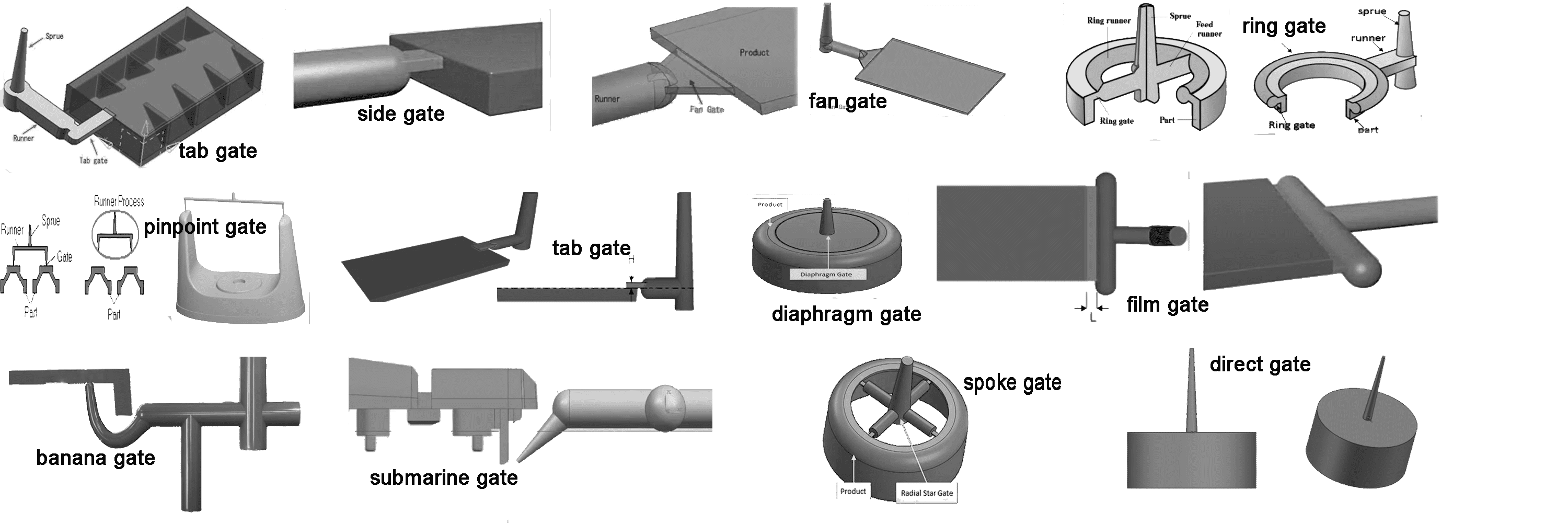
plastic mold gates
- The design of the gate shape, size, and location depend on the plastic, the size, and the structure of the article.
- The shape of the cross-section of the gate is rectangular or circular, and the cross-sectional area should be small, and the length should be short.
- Gate location should generally be selected where the product is thickest without affecting the appearance.
- The shape, quantity, size, and location of the gate will greatly influence the quality of the plastic parts.
- So gate selection is one of the key points in plastic mold design.
-
Direct Gate
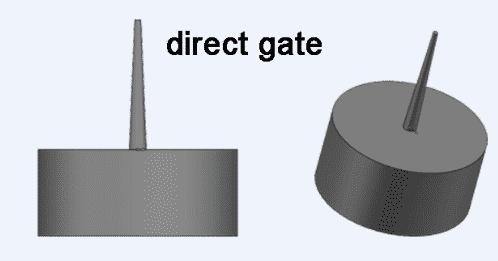
direct gate
- Pros:
- 1) low-pressure loss;
- 2)the processing is simple.
- Cons:
- 1) the stress near the gate is large, and the product stress is uneven and easy to deform.
- 2) it is necessary to remove the gate with extra works manually. Also, it will leave obvious gate marks on the product surface.
- Application:
- 1) it is suitable for large and deep barrel-shaped parts. For plain parts, it is prone to warpage due to shrinkage and stress.
- 2) for parts that are not allowed to have gate marks on the surface, the gate can be set into the inner surface of the part, which is an inverted mold.
https://bit.ly/3zWY7cQ
Comments
Post a Comment